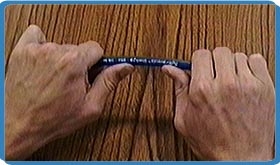|

|
|
Frames & Materials
Page: 3 of 4
|
|
Yield Strength, Ultimate Strength, and Elasticity Activity
When a bicycle maker chooses a material to make a bike
frame, he or she usually considers the following properties of the material.
Elasticity: When an object responds to bending or stretching
by returning to its original shape, it is said to have a high level of elasticity.
A material which bends and then holds the bent shape has very little elasticity.
Yield Strength: This is the amount of the force needed
to bend a material to a point where it cannot return to its original shape.
Ultimate Strength: This is the amount of force needed to break a material.
This is the point at which a bicycle frame breaks apart, usually with dangerous
consequences for the rider.
|

|
A wooden pencil can be surprisingly flexible.
|
|
|
What You'll Need:
-
A plastic comb
-
A rubber band
-
An ordinary Bic ballpoint pen
-
A pencil
-
A paper clip
|
|
|
To Do:
Try bending and stretching the various objects. Which
material do you think has the greatest elasticity? Which has the least?
Which has the greatest yield strength? Which has the least? How about ultimate
strength?
Decide which material would be good for a bike frame, based
on strength and elasticity.
|

|
Do you have one of those fat "Husky" pencils? You'll find it's
much harder bend or break than an ordinary pencil. Bicycle manufacturers
will increase the diameters of tubes to reduce "flexing" and to
make frames stronger.
|
|
|
Futher explorations:
Is there a material for which the yield strength and the
ultimate strength are very close? Which one? Would this be a good material
for a bike frame?
Can a material have a low elasticity and a low yield strength,
and still have a high ultimate strength? Which of your common materials
has this characteristic?
|
|
What's Going On?
The various materials used for bicycle frames are in many
ways similar to the materials you've used here.
Steel, like the paper clip, has good ultimate strength,
with a much lower yield strength. This is good, since it means that a steel
frame will bend well before it breaks, lessening the chance of a disastrous
crash. Unlike the paper clip, steel used for bikes has pretty good elasticity.
This combination of properties has made steel a longtime favorite of frame
builders. Steel's only drawback is its relatively high weight.
|
|
Aluminum has recently become a choice material for frames,
because of its very light weight. However, aluminum has a yield strength
very close to its ultimate strength. In other words, it is quite brittle,
and prone to breaking. This has many dangerous consequences for the rider
of an aluminum bike, so frame makers have responded by over-building aluminum
bikes with very large tubes and thick welds, to lessen the chance of frame
breakage. The wooden pencil has properties similar to aluminum: light weight,
high strength, and brittleness. Wood, like aluminum, will only bend slightly
before breaking.
|

|
This folding bicycle has a very large diameter top tube, which helps give
the bicycle strength.
|
|
|
Other materials, like carbon fiber and titanium, are similar
in qualities to the plastic comb and pen: light weight, high elasticity,
high ultimate strength, relatively low yield strength. This means that frames
made of these materials need to be designed well, in order to be stiff enough
to resist pedaling forces. It also means that such frames are extremely
light and resilient. However, these materials are extremely expensive, putting
carbon-fiber or titanium frames out of reach for all but the wealthy or
the fanatic racer.
|
|
|
Frames & Materials
Page: 3 of 4
Select "Forward" below to continue
|

©
Exploratorium
|

